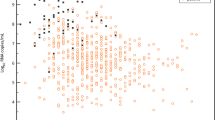Abstract
The purpose of this study was to determine the rate of decline in the diagnostic yield of influenza PCR assay after oseltamivir administration, and to identify risk factors for prolonged shedding. This was a prospective observational study. We included adult inpatients with clinical signs of influenza during the influenza seasons 2015 and 2016, who had positive influenza PCR tests and who were treated with oseltamivir. Clinical follow-up and repeat PCR testing were performed on days 2, 4 and 6 after the first positive test. We defined prolonged shedders as patients who still required hospitalization and had a positive PCR assay on day 4. Risk factors for prolonged shedding were assessed in univariate and multivariate analyses. A total of 215 patients were included in our study. The median age was 64 years and 49.3% were men. The main influenza type was H1N1 (50.1%). Rates of PCR positivity among evaluable patients on days 2, 4 and 6 were 142/215 (66%), 50/78 (64.1%) and 20/30 (66.6%), respectively. Independent risk factors for prolonged shedding (50 patients) included hypoxemia [odds ratio (OR) 2.55, 95% confidence interval (1.3–5.1)] and lower diastolic blood pressure [OR 0.94, 95% CI (0.92–0.97)] on admission. Negative PCR tests taken more than 48 h after initiation of treatment had low diagnostic yield. More severe disease, manifested by hypoxemia and lower blood pressure, is associated with prolonged shedding on oseltamivir treatment.

Similar content being viewed by others
References
World Health Organization (2014) Influenza (seasonal). Fact sheet no. 211. World Health Organization, Geneva. March 2014. Accessed at: http://www.who.int/mediacentre/factsheets/fs211/en/
Kim H, Hur M, Moon HW, Yun YM, Di Somma S (2017) Multi-marker approach using procalcitonin, presepsin, galectin-3, and soluble suppression of tumorigenicity 2 for the prediction of mortality in sepsis. Ann Intensive Care 7(1):27
Call SA, Vollenweider MA, Hornung CA, Simel DL, McKinney WP (2005) Does this patient have influenza? JAMA 293(8):987–997
Petrozzino JJ, Smith C, Atkinson MJ (2010) Rapid diagnostic testing for seasonal influenza: an evidence-based review and comparison with unaided clinical diagnosis. J Emerg Med 39(4):476–490 e471
Harper SA, Bradley JS, Englund JA, File TM, Gravenstein S, Hayden FG, McGeer AJ, Neuzil KM, Pavia AT, Tapper ML et al (2009) Seasonal influenza in adults and children--diagnosis, treatment, chemoprophylaxis, and institutional outbreak management: clinical practice guidelines of the Infectious Diseases Society of America. Clin Infect Dis 48(8):1003–1032
Nicholson KG, Aoki FY, Osterhaus AD, Trottier S, Carewicz O, Mercier CH, Rode A, Kinnersley N, Ward P (2000) Efficacy and safety of oseltamivir in treatment of acute influenza: a randomised controlled trial. Neuraminidase inhibitor flu treatment investigator group. Lancet 355(9218):1845–1850
Treanor JJ, Hayden FG, Vrooman PS, Barbarash R, Bettis R, Riff D, Singh S, Kinnersley N, Ward P, Mills RG (2000) Efficacy and safety of the oral neuraminidase inhibitor oseltamivir in treating acute influenza: a randomized controlled trial. US oral neuraminidase study group. JAMA 283(8):1016–1024
Fry AM, Goswami D, Nahar K, Sharmin AT, Rahman M, Gubareva L, Azim T, Bresee J, Luby SP, Brooks WA (2014) Efficacy of oseltamivir treatment started within 5 days of symptom onset to reduce influenza illness duration and virus shedding in an urban setting in Bangladesh: a randomised placebo-controlled trial. Lancet Infect Dis 14(2):109–118
Ng S, Cowling BJ, Fang VJ, Chan KH, Ip DK, Cheng CK, Uyeki TM, Houck PM, Malik Peiris JS, Leung GM (2010) Effects of oseltamivir treatment on duration of clinical illness and viral shedding and household transmission of influenza virus. Clin Infect Dis 50(5):707–714
Lieberman D, Shimoni A, Keren-Naus A, Steinberg R, Shemer-Avni Y (2009) Identification of respiratory viruses in adults: nasopharyngeal versus oropharyngeal sampling. J Clin Microbiol 47(11):3439–3443
Hayden FG, Treanor JJ, Fritz RS, Lobo M, Betts RF, Miller M, Kinnersley N, Mills RG, Ward P, Straus SE (1999) Use of the oral neuraminidase inhibitor oseltamivir in experimental human influenza: randomized controlled trials for prevention and treatment. JAMA 282(13):1240–1246
Zambon M, Hays J, Webster A, Newman R, Keene O (2001) Diagnosis of influenza in the community: relationship of clinical diagnosis to confirmed virological, serologic, or molecular detection of influenza. Arch Intern Med 161(17):2116–2122
Li IW, Hung IF, To KK, Chan KH, Wong SS, Chan JF, Cheng VC, Tsang OT, Lai ST, Lau YL et al (2010) The natural viral load profile of patients with pandemic 2009 influenza a(H1N1) and the effect of oseltamivir treatment. Chest 137(4):759–768
Muthuri SG, Venkatesan S, Myles PR, Leonardi-Bee J, Al Khuwaitir TS, Al Mamun A, Anovadiya AP, Azziz-Baumgartner E, Baez C, Bassetti M et al (2014) Effectiveness of neuraminidase inhibitors in reducing mortality in patients admitted to hospital with influenza a H1N1pdm09 virus infection: a meta-analysis of individual participant data. Lancet Respir Med 2(5):395–404
Author information
Authors and Affiliations
Corresponding author
Ethics declarations
Conflict of interests
All the authors declare that they have nothing to disclose and confirm no financial interest in a business or commercial entity that relates to the manuscript.
Ethical approval
The study was approved by the institution’s IRB.
Informed consent
Informed consent was obtained from all patients.
Rights and permissions
About this article
Cite this article
Khoury, J., Szwarcwort, M., Kra-oz, Z. et al. Duration of viral shedding and factors associated with prolonged shedding among inpatients with influenza treated with oseltamivir: a prospective cohort study. Eur J Clin Microbiol Infect Dis 37, 319–323 (2018). https://doi.org/10.1007/s10096-017-3135-0
Received:
Accepted:
Published:
Issue Date:
DOI: https://doi.org/10.1007/s10096-017-3135-0




